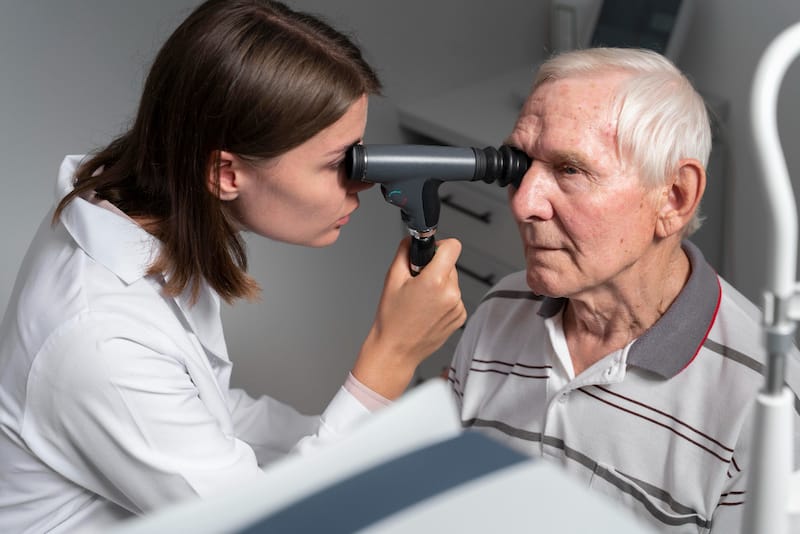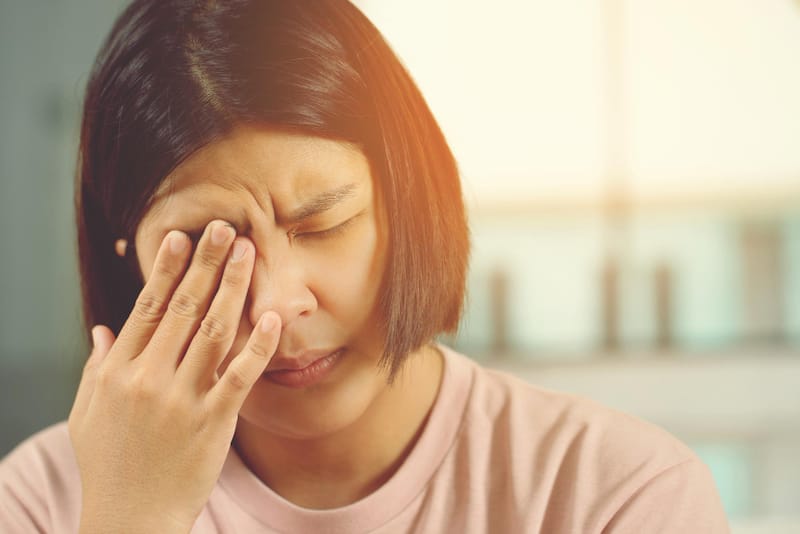The risks of Blepharitis revolve around the fact that there is no permanent cure for it, and it won’t go away on its own. Ignoring it can also lead to other complexities like corneal ulcers. Many choose to practice the use of baby shampoo for eye treatment during Blepharitis. While this can provide a certain relief, in some instances, it can irritate your eyes further due to harmful ingredients in it. This begs the need to get involved in other treatment options like antibiotics and anti-inflammatory treatments. The best and most effective alternatives that you could go for are in-office procedures and tea tree oil formulations. You can also practice lifestyle changes like staying hydrated and avoiding eye irritants like makeup, lenses, and strong soaps.
Blepharitis, which is inflammation in your eyelids, can be quite complex as it can occur due to various triggers and pre-existing conditions like seborrheic dermatitis, infections, skin conditions, allergies, and even eyelash mites or lice.
This wide variety of causes is best explored with the aid of an optometrist, who is an eye care professional.
While receiving medical treatment, you can also opt for home remedies, which is where the popularity of baby shampoo comes in.
However, popularity alone doesn’t define the effectiveness of such home remedies.
What is Blepharitis, and how bad can it get? How effective is baby shampoo in treating Blepharitis? Is baby shampoo treatment alone enough for Blepharitis?
Are there other alternatives to baby shampoo for Blepharitis? What are the dos and don’ts throughout the treatment of your Blepharitis?
What is Blepharitis, and how bad can it get?
Blepharitis is an inflammation that occurs along your eyelids when the oil glands at the base of your eyelashes get congested and become irritated.
While this condition might leave your eyes feeling uncomfortable, it doesn’t pose a threat to your eyesight and isn’t contagious in any way.
Unfortunately, Blepharitis is most often a chronic condition that cannot be cured entirely. But you surely can treat it to an extent where it won’t seem as noticeable.
If you decide not to treat your Blepharitis, it may even worsen and pave the way for more serious eye conditions like corneal ulcers, pink eye, styes, chalazions, and tear film complications.
How effective is baby shampoo in treating it?
When it comes to this eye condition, baby shampoo has received undeniable popularity as an effective home remedy for Blepharitis.
You can follow this remedy by simply adding a few drops of baby shampoo into a glass of water.
You can insert a cotton swab in the liquid and dab it across your eyelids and eyelashes to treat Blepharitis.
While baby shampoo is mild and can cause a soothing effect on irritated eye conditions, it still contains various ingredients that can sometimes be harmful to our eyes, one of the most sensitive parts of our body.
This was proved in 2013 when Johnson & Johnson decided to remove ingredients like formaldehyde and 1,4-dioxane from its baby shampoo. Long-term exposure to such ingredients can cause or worsen eye irritation.
Cross-checking with various studies conducted will help you understand whether the baby shampoo is the best option for you.
A 2020 study conducted by the US National Library of Medicine revealed that the success rates of baby shampoo and commercial eyelid cleaners didn’t have significantly different results on eye conditions such as Blepharitis.
Meanwhile, a randomized trial conducted in 2017 revealed that eyelid cleansers have a better effect on Blepharitis than baby shampoo does.
Another clinical trial concluded that a larger number of participants favored the eyelid cleanser over the baby shampoo remedy as it was more effective in minimizing inflammation and lipid layer function in our eyes.
Given these scientific facts, it might be time for you to consider alternative treatments for baby shampoo.
Is the baby shampoo treatment enough for your eyelids?
Blepharitis can usually be controlled to a great extent by following simple eyelid hygiene routines like regularly washing your eyelids with the help of baby shampoo and making sure you wash your eyelashes, eyebrows, and hair daily.
However, in certain instances, your Blepharitis might be aggravated, and in such situations, you’ll have to turn to other options as listed below.
- Antibiotics – When it comes to complex eye conditions like acute ulcerative Blepharitis caused by bacterial infection, your doctor will prescribe you over-the-counter antibiotic ointments such as Polysporin and eye drops such as Polytrim. In certain instances, oral antibiotics are also recommended.
- Immunomodulators – Such medical drugs have proven to be effective in decreasing inflammation by blocking our body’s natural immune response.
- Root cause treatment – Since various factors can trigger Blepharitis in our eyes, it’s important to first treat the root cause. Conditions like dandruff, dry eyes and other eye complications can lead to Blepharitis. Your doctor can help identify the root cause and prescribe appropriate medication to counter it.
- Anti-inflammatory treatment – Your doctor might recommend various eye creams, and steroid eye drops when home remedies aren’t working as effectively. Such medication will even help treat any underlying condition causing your Blepharitis as well.
What are some alternatives to baby shampoo for Blepharitis?
Since we cannot entirely rely on baby shampoo throughout our struggle with Blepharitis, it’s best to look out for healthier and more effective alternatives, as suggested below.
- Lid wipes – These are pre-moistened wipes that solely exist to remove debris and dust particles around your eyes. They do not contain compounds that can be harmful to the eye as in baby shampoo and are an easily accessible, inexpensive alternative. In a 2020 review conducted by the US National Library of Medicine, patients were noted to reap benefits from the use of eyelid wipes within 1 or 2 months.
- Tea tree oil formulations – Tea tree oil contains 100 chemical compounds, while its main compound terpinene-4-oil contains antibacterial activity. Lid scrubbing with this concoction has proven to be efficient in various instances. A 2018 study revealed the efficacy of this formulation in improving all symptoms of Blepharitis and tear film stability significantly.
- Warming masks – These are a popular option approved by eye care clinics. Nowadays, silicone-beaded warming masks provide a more sustained moist heat when compared to traditional masks. It can also be used repetitively with absolutely no adverse impact.
- Hypochlorous acid solutions – This solution effectively provides relief for those suffering from chronic irritation and inflammation in their eyes. Blepharitis patients can also, therefore, benefit from this, as it removes debris from the eyes and has an overall soothing effect.
- BlephEx In-office procedures – This treatment is carried out by doctors who carefully remove any debris, bacteria, and bacterial toxins from your eyes and exfoliate your eyelids. By getting regularly treated, you can stay away from chronic symptoms of Blepharitis, and this procedure takes just a few minutes to perform.
The dos and don’ts of treating your Blepharitis
Following a single treatment isn’t enough in the face of chronic Blepharitis.
You also need to take precautions in following proper eye hygiene and staying away from factors that may worsen your condition.

The following table will give you an idea of what to do and what not to do if you suffer from Blepharitis.
| Dos of treating Blepharitis | Don’ts of treating Blepharitis |
|---|---|
| Find out the underlying cause of your Blepharitis. Health conditions like diabetes and vitamin A deficiencies are also known to trigger Blepharitis or dry eyes. | Don’t use strong shampoos and soaps on your eyes. Sometimes even mild soaps can irritate your eyes. So be sure when selecting your products. |
| Stay hydrated at all times. Hydration can reduce your blepharitis irritation as eye dryness can be prevented. Being dehydrated can stop your body from naturally providing tears and worsen your Blepharitis. Using a humidifier at home can also help increase moisture and reduce dryness. | Don’t rely entirely on over-the-counter eye drops. Although it may provide relief at first, this won’t be long-lasting since it doesn’t treat the root cause of your Blepharitis. |
| Modify your diet to include many fruits and vegetables. They contain various nutrients essential for your eye health, such as vitamin A and Omega 3’s. | Don’t be around cold, windy environments as Blepharitis is known to worsen in such weather conditions. Even air-conditioned environments can further trigger your dry eyes. |
| Make an appointment with an Optometrist. This is important if your condition worsens, as home remedies can only provide temporary relief. Receiving proper and regular in-office treatments will be far more effective in bettering your Blepharitis. | Don’t use your computer and phone for too long. When our eyes are exposed to digital screens for a prolonged period, it can negatively impact how quickly our tears evaporate and worsen the dryness in our eyes. Sleep deprivation, too, can have a similar effect. |
| Get yourself checked out by a dermatologist if you’re experiencing an active skin disease, as such diseases can trigger or worsen Blepharitis. | Don’t wear contact lenses or eye makeup while treating your eyes for Blepharitis, as the eyes can be too sensitive during this time. |
FAQs
Can certain foods aggravate Blepharitis?
Just as fruits and vegetables can help treat your Blepharitis, certain foods can also trigger your Blepharitis.
Processed and fried foods, fizzy drinks, sugar, and white flour aggravate this eye condition and can sometimes lead to flare-ups of Blepharitis.
Why does Blepharitis keep coming back?
If you have excess bacteria around and on your eyelids (and at the base of your eyelashes), Blepharitis can keep getting triggered after a while, despite being on medication.
If the oil glands in your eyelids get clogged constantly, you can expect Blepharitis from time to time. Certain underlying conditions also might be why you can’t tone down your Blepharitis.
Can you prevent Blepharitis from occurring?
Lifestyle changes can help you prevent Blepharitis.
Keeping your eyelids clean at all times, staying away from strong soaps and shampoos, and removing eye makeup before bedtime can help you achieve this goal.
Conclusion
Blepharitis isn’t specific to any category of people. However, it has been commonly seen among people over the age of 50.
In a 2022 study conducted in the US, it was revealed that 47% of patients seen by an optometrist showed signs of Blepharitis.
As Blepharitis mainly caters to the dry irritation of the eyes, it’s best to always take measures to keep your eyes clean and moist.
Without simply focusing on treating your eyes, you can also take a step further and add positive routines to your lifestyle, like staying hydrated and consuming fruits and vegetables that benefit your eyes.
Precautions are never too much when it comes to body health.




